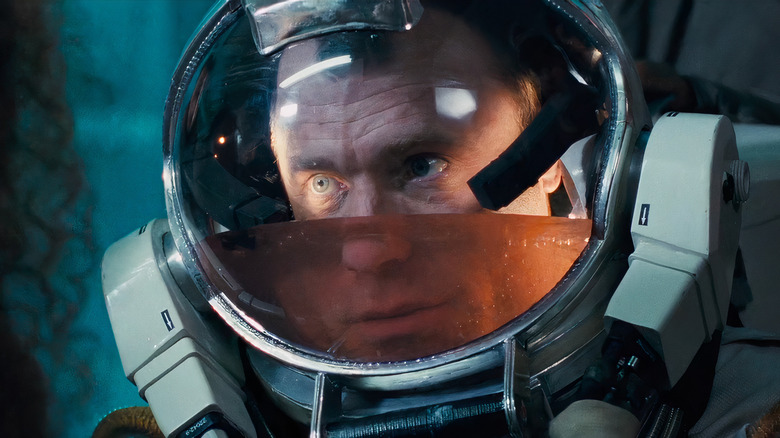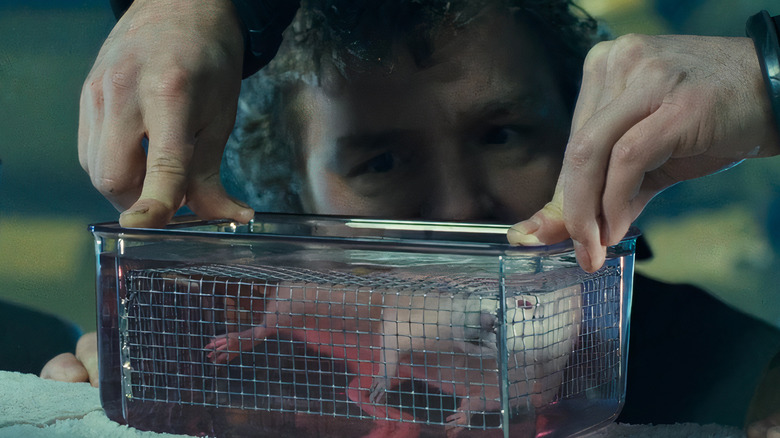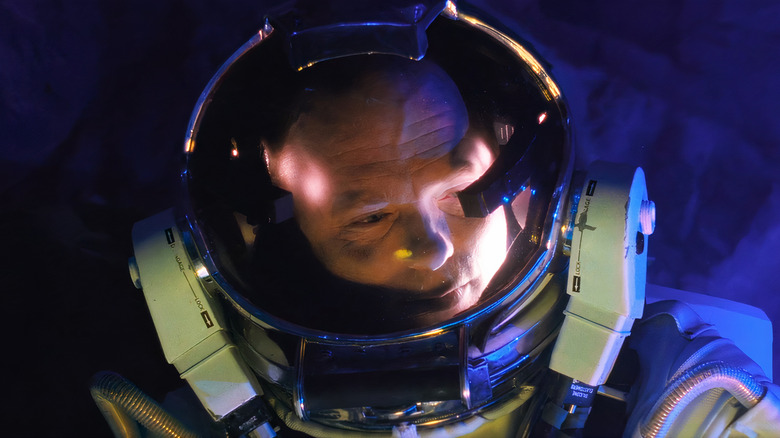The Breathable Liquid In James Cameron's The Abyss Is Real
When fans think of James Cameron's 1989 underwater thriller "The Abyss," starring Ed Harris, a few memorable moments are likely to quickly resurface, like the neon aliens or the infamous water face scene. While there is no denying the Academy Award-winning feature offers plenty of science fiction, several aspects of the film are surprisingly real, like the breathable liquid Harris' character, Bud Brigman, uses toward the end to defuse the nuclear warhead.
The concept of liquid breathing is first introduced when US Navy SEAL Ensign Monk (Adam Nelson) gives a demonstration of how the fluid breathing system works by submerging the rat owned by Alan "Hippy" Carnes (Todd Graff). It was confirmed that when the scene was filmed, the rodent survived by actually breathing the liquid. "The point of the rat-drowning scene was to see the rat survive," said Van Ling, James Cameron's research assistant, to the Los Angeles Times, "so rest assured that we didn't spend the time and effort consulting with various experts and the $400 a gallon for real liquid fluorocarbon just to kill the poor thing. Under the guidance of fluid breathing experts from Duke University, we did the scene for real ... and the rat survived the scene, for real."
"The Abyss" may be a work of fiction, but the idea of liquid breathing is quite real, and it's been around a lot longer than people think.
The Abyss and breathable liquid have a shared history
Despite seeming like a far-out science fiction gimmick James Cameron created for "The Abyss," the idea of liquid breathing has been around since the 1960s. Johannes Kylstra began conducting studies with animals in 1962, and after successful trials utilizing oxygenated fluorocarbons, he eventually tested his findings on commercial diver Frank Falejczyk. Despite Falejczyk getting pneumonia afterward, his ability to breathe the oxygenated liquid proved the concept's validity.
When sharing his experiences during a presentation in about 1970, Falejczyk met James Cameron when Cameron was about 16 years old, and the enlightening interaction inspired the aspiring filmmaker to pen a short story that eventually evolved into "The Abyss." In 1987, before making the movie, the director also consulted with Kylstra, who gave him the rundown on everything relating to his research, including the formula for the rat scene. "Kylstra told me how to do it with the rat," the director is quoted as saying on page 94 of the book "James Cameron: Interviews," published in 2012. "... He told me what to get, how to heat the stuff, how to do the rat."
As a result, individuals who helped pioneer the innovative science behind the film's crucial plot point also had a heavy hand in the production of "The Abyss." While the idea may have sparked James Cameron's creativity, the idea of liquid breathing has a lot more potential than just adding excitement to the third act of a movie.
Breathable liquid could be a game changer in several fields
Even though it definitely made a difference in "The Abyss," there is no denying there are a number of ways that inhaling oxygen-rich liquids rather than air could be a game changer in real life. Besides possibly providing a safer experience for deep-sea divers, liquid breathing could also facilitate certain endeavors in the medical field and space travel.
Breathable liquid has made a splash in the realm of medical treatments in several areas. Studies of partial liquid ventilation, such as in the New England Journal of Medicine, have shown promising results for increased survival rates for premature infants struggling with respiratory issues. The method of liquid ventilation could also be used to deliver medicine or gene product directly to the lungs (per Frontiers in Physiology). And liquid perfluorocarbons have the ability to cool the body post-cardiac arrest to deter any further tissue damage from taking place (per Transactions of the American Clinical and Climatological Association). These areas of research are still ongoing.
In terms of space travel, anything that helps people breathe in harsh conditions would be a welcome addition. When it comes to launching into space or returning to Earth's atmosphere, total liquid immersion could prevent an astronaut from suffering the physical stress normally associated with extreme G forces. However, the liquid would have to have a density similar to water, as perfluorocarbons are too dense for the total immersion of human tissue.
While talking to aliens or disarming nuclear warheads probably won't top the list, it is fascinating how many ways breathable liquid could aid humanity, and it will be interesting to see how things play out as people continue to make the idea more plausible.


